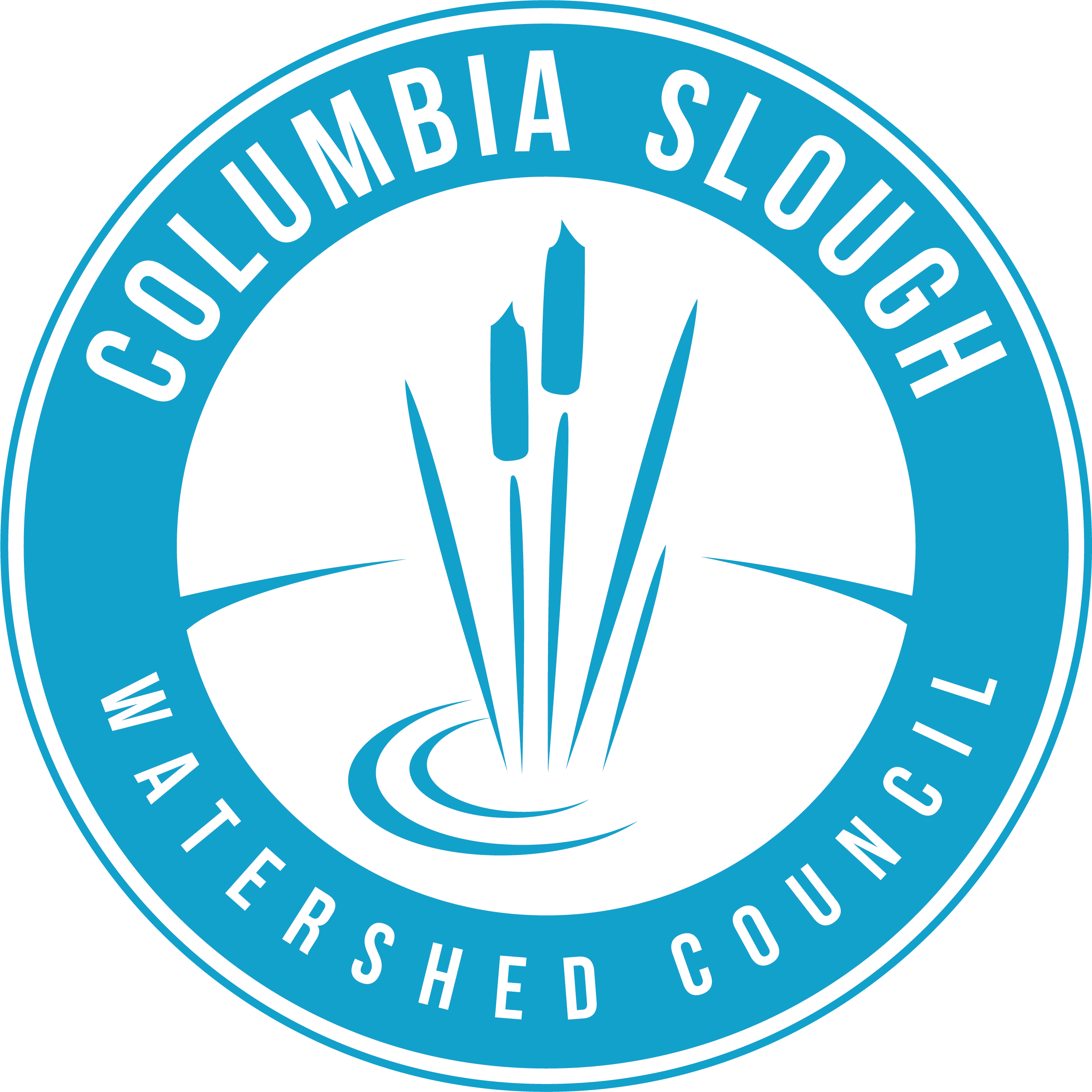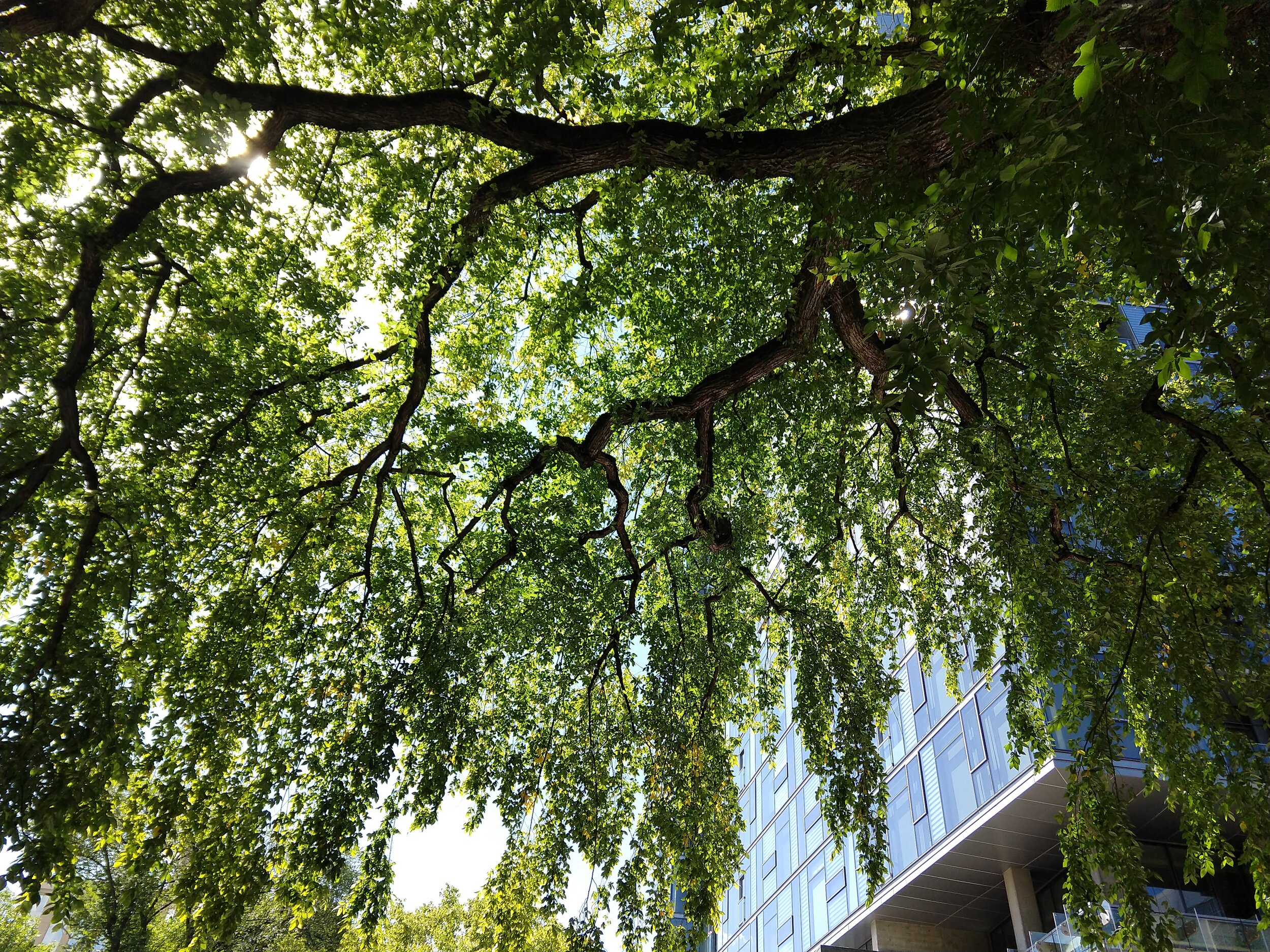From Seedlings to Shady Streets: All About Portland’s Environmental Services’ Tree Programs (Part 1)
Blog post by Thomas Meinzen, CSWC Program Associate, with Lea Wilson, Matt Krueger, and Ryan Durocher, Portland Bureau of Environmental Services
March has arrived, and that means it’s time to plant trees in Portland! We at the Council have been thinking a lot about trees lately. With help from volunteers, we’ve been planting native trees and shrubs to restore sites in the watershed, connecting with businesses to explore how trees might help improve worker conditions in the industrial corridor, and thinking about how trees relate to urban heat and equity issues across Portland.
Council volunteers plant native trees and shrubs in the median of NE Ainsworth Street.
There’s a lot to learn about trees and tree-planting here in Portland. Who plants Portland’s trees? Which species are best, and how does climate change factor in? How can you get involved? To answer these questions and more, we talked with experts at the City of Portland Bureau of Environmental Services (BES), which runs two important programs aimed at planting and caring for trees and expanding Portland’s urban canopy.
One of these programs is the Watershed Revegetation Program, which began in 1995 as part of an effort to reduce water temperatures in the Columbia Slough by establishing riparian tree canopy for shade. According to Ryan Durocher, Watershed Revegetation Program Manager, this program began by developing public-private partnerships with property owners to reforest their Slough banks, typically converting near-monocultures of blackberry or reed canary-grass into diverse, complex forests of native species such as black cottonwood, red alder, and Oregon ash. In recent years, as BES, Portland Parks & Recreation, and Metro have acquired wetland, floodplain, and other open space parcels, the Program’s revegetation work has focused more on publicly-owned natural areas. In its 25-year history, the Watershed Revegetation Program has planted more than 816,000 native tree seedlings in the Columbia Slough watershed, primarily in riparian areas and wetlands. Wow!
Most residents, however, are more likely to interact with the Bureau of Environmental Services’ Tree Program, which focuses on planting trees in the “built environment”—yards, street edges, parking lots, and neighborhoods. Unlike restoration and revegetation projects, which typically plant seedlings, this program begins with larger trees (usually 6-10 feet tall) and partners with property owners to maintain and care for trees once they are planted. This program is making important strides to address the inequalities in Portland’s urban canopy; we talk about these evolving priorities and equity issues in a follow-up blog post. First, we’d like to share an interview with Lea Wilson and Matt Krueger of the Environmental Services Tree Program about the nuts and shoots of Portland tree planting.
CSWC: I've read that the Environmental Services Tree Program has helped plant 50,000 trees across Portland since 2008. That's an amazing achievement, especially considering that each tree means a partnership with a local property owner! How has this been accomplished? Where are the trees grown, and who plants them?
Lea and Matt: We have three primary mechanisms by which we plant trees: one, we contract with Friends of Trees to help make trees planted through their non-profit more affordable; two, we pay on-call contractors directly to plant and water trees at multi-family and commercial properties; and three, we have the Treebate incentive, which provides a one-time credit on a customer’s sewer/stormwater/water utility bill for qualifying residential yard trees. We primarily source trees from the Willamette Valley, but have looked further afield for species we think might do well as climate changes. While our program provides tree-planting opportunities city-wide, our primary goal for the last 10 years has been to get trees planted in low-canopy neighborhoods and to reduce barriers to tree planting and canopy access for Portlanders who identify as low-income or BIPOC (Black, Indigenous, and People of Color). (Read more about this in Part 2!)
The 145-yr-old Burrell Elm, one of Portland’s most beloved street trees and the first of Portland’s Heritage Trees, in downtown Portland.
How can people help out in this effort?
Plant a tree if you have the space! Water that tree during the first few summers to get it going! Come out to volunteer at a planting event with Friends of Trees.
Beyond that, one of the primary ways to help out is by being informed tree advocates. Take care of the mature trees you have. Learn how to make a good pruning cut. Hire a Certified Arborist for professional care for larger trees. Talk to others about their concerns about trees and help people problem-solve so that they can reduce the risks and maximize the benefits of trees in their own lives, which we all benefit from.
What tree species are most critical to your efforts to expand Portland's urban canopy?
In general, the trees most critical to our efforts are ones that perform well in the urban environment and in our climate (now and looking to the future, as scientists predict Portland’s climate will become more like that of central California within one tree’s lifetime). We look for hardiness, drought tolerance, heat tolerance, and we also consider form, strength, disease resistance, and longevity. While we plant for diversity and plant many dozens of different trees, we have a focus on species that are native to the Willamette Valley and southwards into California. A few priority trees for us are our iconic native Oregon oak, evergreen oak species from south of us such as canyon live oak and interior live oak, Pacific madrone, and conifers such as incense cedar and Willamette Valley ponderosa pine. A few others to mention, which are not native to the west coast, are crape myrtle and strawberry trees (both good for small spaces) and ginkgo.
Finally, are there any tree planting or tree maintenance tips that you'd like to share with Columbia Slough watershed residents?
Watering your newly planted tree is key. Spraying it with a hose for a few moments is not enough; the water needs to soak through the root zone at the base of the tree. It depends on the size and species, but 10-15 gallons per week is a pretty good rule of thumb for your first couple summers. Frequency can be scaled back after that. If appropriate trees are planted, most will be established and self sufficient after 3-4 years. Keeping string trimmers, lawn mowers, and other potential damaging things away from the base of your tree is also important. What might appear as minor damage to a young tree can lead to disease, deformation, and major long-term impacts. It’s good to keep a ring of bark mulch around the base of your trees as a “safe zone”. For more tips, check out our cheat sheet on tree planting.
Pruning is also key to long-term maintenance. That begins with understanding how to prune young trees to hopefully avoid structural problems with mature trees. If you’re interested, taking a class to learn young tree pruning is a great idea; it’s also always best to consult with a certified arborist, especially as your tree matures. Check out Portland Parks & Recreation Urban Forestry’s webpage for information on tree workshops, pruning resources, and permit requirements for tree care.
Portland’s many street trees give color to the city’s horizon. Photo by truflip99.
Thank you to Lea Wilson, Matt Krueger, and Ryan Durocher of the Bureau of Environmental Services for their contributions to this piece. Hear more from them in Part 2! Plus, click here to learn more about the Tree Program and Portland’s street trees, and to sign up to get free trees added to your street or commercial/industrial/multi-family property. To learn how to get discounts to your bills from planting trees and mitigating stormwater on your property, visit the Clean River Rewards page. And to volunteer, visit Friends of Trees or our Events page!



